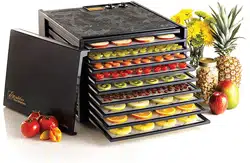Loading ...
Loading ...
Loading ...

5
should only wiped clean and NOT placed in the dishwasher. DO NOT USE harsh chemicals
or abrasive materials for cleaning. DO NOT immerse any portion of this appliance in water
except the trays and poly screens.
Your dehydrator has been equipped with a removable door. This solid door prevents light
from fading the colors or withdrawing nutrients from the food as it dries. Treat your door
carefully to prevent it from getting scratched. To clean, use a damp sponge or soft cloth only.
PREPARATION
There is really no right or wrong way to prepare your food for drying. By following these few
guidelines, success will be yours.
Pre-treatment
Pretreating food is not an essential procedure when using your Excalibur® Food Dehydrator.
There are basically two types of pre-treatment, dipping and blanching. The fast drying times
and controlled conditions under which your unit operates dries food before it has a chance
to spoil. However, pretreating will help maintain:
• Color: reduces oxidation of foods such as apples and potatoes keeping them from
turning a rust-like color.
• Nutrients: helps retain the minimal loss which tends to occur during the drying process.
• Texture: the chance for fiber deterioration in the produce is lessened.
There are basically two types of pre-treatment: dipping and blanching.
Dipping
Dipping is a treatment used primarily to prevent fruits or vegetables from oxidizing.
The following are various pre-treatment dips with which you may want to experiment.
• Sodium Bisulfite: When mixed with water, sodium bisulfite is a liquid form of sulfur. It is
the most effective and least expensive anti-oxidant. Use only a food-safe grade of sodium
bisulfite that is made especially for dehydration. Sodium Bisulfite is available
directly through Excalibur®.
If subject to sulfur allergic reactions, check with your physician before using Sodium Bisulfite
as a dip.
• Fruits: Mix 1 1/2 tablespoons of Sodium Bisulfite in one gallon of water. Soak
fruit slices for five minutes and halved fruit for fifteen minutes. Rinse.
• Vegetables: Recommended for steam blanching only. Add 1 teaspoon Sodium
Bisulfite to each cup of steaming water and blanch as you would normally. This is particularly
recommended for vegetables to be stored in excess of three months.
Loading ...
Loading ...
Loading ...
